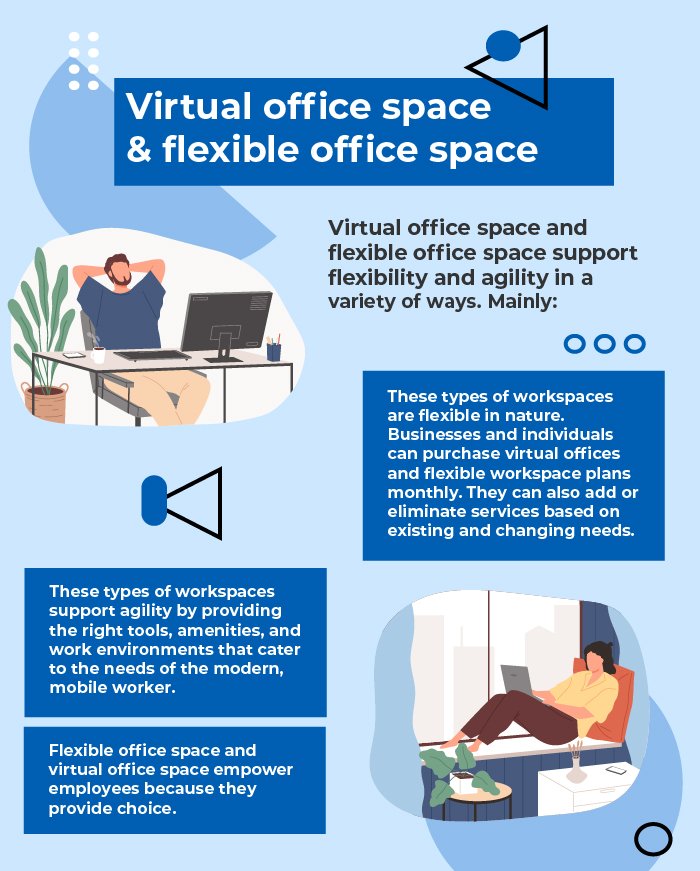- What Does the Shift to Remote + Hybrid Work Mean for the Workplace?
- The Impact of Remote and Hybrid Work on Commercial Real Estate.
- Adapt or Get Left behind: Embracing Virtual Offices
Following the COVID-19 pandemic, there is no going back to normal.
The way people go about life and work has fundamentally changed, and this is not necessarily a bad thing. In the business world, the pandemic has accelerated trends that were already underway—remote work, digital transformation, and flexible work arrangements — to name a few. As a result, the global economy will increasingly rely on virtual offices, flexible workspaces, and cloud-based solutions to support hybrid and remote teams.
This is the second article in a 4-part series that explores the changing nature of workspaces and why flexible workspaces solutions are the new normal for businesses worldwide.
The New “Normal”

The coronavirus pandemic created a global experiment on remote work, and the results are promising for workers worldwide.
Survey after survey found that workers were equally or more productive when working remotely compared to in-office work. If ever companies were worried that people working from home didn’t work enough, the pandemic proved them wrong, with surveys finding that those working from home were working longer hours compared to when they were in the office.
Workers not only like being able to work remotely, but they expect to be able to continue doing so in the future.
Let’s look at some key statistics.
- 52% of remote workers noted that they would consider leaving their co-located company for a remote role. -GitLab
- The top 3 remote work benefits for employers are increased productivity (42%), increased efficiency (38%), and increased employee morale (31%). -GitLab
- If remote work was no longer an option, 1 in 3 people would not go back to their commute; 26% would look for a new remote role, and the rest would relocate or retire. -GitLab
- 75% of people are the same or more productive during COVID-19 while working from home. -OwlLabs
- 1 in 2 people won’t return to jobs that don’t offer remote work after COVID-19. -OwlLabs
- After COVID-19, 80% expect to work from home at least 3x/week. -OwlLabs
- 23% of full-time employees are willing to take a pay cut of over 10% in order to work from home at least some of the time. -OwlLabs
- 57% of employees want an office that is closer to their home. – The Instant Group
- 77% of employees say that a more conveniently located office is a must-have for their next role. -The Instant Group
- 65% of respondents report wanting to be full-time remote employees post-pandemic, and 31% want a hybrid remote work environment—that’s 96% who desire some form of remote work. -FlexJobs
- 5 out of 100, compared to 71 for in-office employees. Remote employees are more likely to report being satisfied with their jobs than office-based workers (57% vs. 50%). -CNBC
- 95% of respondents say that their productivity has been higher or the same working from home, and 51% report being more productive when working remotely. -FlexJobs
- A majority of CEOs surveyed (78%) say the shift towards remote collaboration is enduring. -PwC
- More than half of respondents (54%) believe the trend away from traditional employment and towards the gig economy is here to stay. -PwC
- More than half (61%) of CEOs believe that the shift towards low-density workplaces will persist. -PwC
What Does the Shift to Remote + Hybrid Work Mean for the Workplace?
If the way we work is changing, then our workplaces should change as well. As it currently stands, traditional office space is proving to be outdated in that it does not respond to current company and employee needs.
Virtual office space and flexible office space—whether coworking or managed office space—are increasingly becoming a top choice among CRE leaders, entrepreneurs, SMEs, and freelancers.
Why?
A couple of reasons.
Flexibility and Agility
The coronavirus taught businesses across all industries that if they want to succeed in the face of uncertainty, they need to be agile and flexible. What does this mean? It means that companies need to be able to adapt to unforeseen circumstances.
Let’s look at flexibility. Traditional CRE leases are rigid in nature; they are cost-prohibitive and tenants that break their original lease face hefty fines. While this used to be widespread practice, the needs of organizations are now rapidly changing and evolving, especially with a more fluid workforce.
A more fluid workforce means that a company’s space needs will vary on a monthly, quarterly, or yearly basis. It makes no sense, then, for companies to keep signing 10- or 15-year leases that do not allow them to grow or contract as needed.
As for agility, it’s all about supporting workers, empowering them to work swiftly and seamlessly—regardless of where and when they choose to work. An agile workplace isn’t a single office location; it could mean a variety of locations (virtual offices, coworking spaces, headquarters, etc.) that support different types of work. An agile workplace is one that will allow teams to collaborate digitally and in-person, and to work synchronously and asynchronously.

The Rise of Satellite Offices
The war for talent is on. The right workplace experience can help companies attract and retain top talent, especially now in a more competitive, remote-driven market.
As a result of the pandemic, workers are increasingly asking for more flexibility and choice in how, when, and where they work. While many workers are looking forward to returning to the office, many are not looking forward to their previous daily commute.
This is changing the dynamic between workers and the workplace.
Pre-pandemic, where people chose to live was partly driven by their place of work. Post-pandemic, experts argue that where people live will dictate where they work.
“This requirement [centralized offices] has determined people’s choice of living space, driven hour-long commutes and the dedication of specific cubicles to individual employees. But now organizations have a much more diverse set of options, from employer-sponsored home offices to distributed coworking locations.”
Deloitte
What does this diverse set of options look like?
A network of offices.
And virtual offices and flexible workspace solutions will be an integral part of the organization’s network of offices.
People are now less likely than ever to commute for a long time. Many are now searching for workspace near their homes. While some companies will set up offices owned in suburban areas (think Dropbox Studio), others will leverage flexible office space to create a network of satellite offices.
Remote-First
The switch to a remote-first approach is widespread and part of the new normal. The coronavirus pandemic helped even the most traditional of industries realize that remote work works. Take, for example, lawyers and accountants.
Rather than paying office rent in city centers to meet with clients, lawyers and accountants have come to realize that they can meet with clients remotely or they can visit clients in their homes (and charge an extra fee for home visits).
However, for these types of professionals, it is important to keep a local presence, access to meeting space, and to have some privacy. Therefore they are using virtual office services to run their remote-first businesses.
Virtual offices are an affordable solution that allows professionals to keep a local presence (renowned business address, phone number), receive mail, improve customer service, and have access to on-demand office and meeting space.
As a result of the shift to remote-first, the virtual office and related services have become an essential part of the workplace ecosystem of the future. The legitimacy and acceptance of virtual offices, therefore, is necessary to accommodate the shift to remote work.
The Impact of Remote-first on Real Estate

As more organizations embrace remote and hybrid work models and rethink their corporate real estate strategies, many are starting to rid themselves of part of their real estate footprint. This means that traditional workspaces will face enormous vacancies.
A prime example of this is Pinterest, which paid $89.5 million to get out of a 490,000 square feet lease in San Francisco. Speaking about the decision, Pinterest Chief Financial Officer Todd Morgenfeld stated:
“As we analyze how our workplace will change in a post-COVID world, we are specifically rethinking where future employees could be based.”
That’s 490,000 square feet that is now vacant.
However, it’s not just the way people work that is changing.
The way consumers interact with companies is changing as well. The remote-first mindset applies not only to where we work, but also how we shop and acquire all sorts of goods.
Just as people can now work from home rather than go to the office, people can shop online and have all sorts of goods delivered to their homes rather than having to go out and visit stores individually. All of this is having a huge impact on commercial real estate.
Commercial spaces—from office buildings to malls—are likely to experience high vacancy rates soon. For one, these spaces tend to be cost-prohibitive for many businesses; for another, the needs for space have fundamentally changed—retailers don’t need as much storage or shop space as they did in the past.
The new economy requires more agile, affordable places to do business. And again, virtual office space and flexible office space will be an integral part of filling these spaces up again in the future of work.
This was already happening pre-pandemic; property owners were leveraging coworking spaces to increase foot traffic in malls and to fill up empty space. Now that people want to work closer to home, having office space in malls, which are typically located near residential neighborhoods, will seem like an even more natural solution to high vacancy rates and declining foot traffic.
Landlords were also turning to flexible workspace operators to fill up empty office space through management agreements, and this trend is accelerating now due to the COVID-19 pandemic.
According to JLL:
“Office landlords saddled with empty space as a result of the coronavirus pandemic believe they’ve landed on a way to help fill it back up: teaming up with flexible space operators. (…) [A}s workers return to the office, flex space is being buoyed by businesses deploying less capital into real estate and employees who have come to expect more choice over how and where they work.”
Flexible workspaces, like coworking, office the choice that people and companies now expect.
Traditional commercial spaces are losing their economic attractiveness. They are cost-prohibitive, they don’t respond to current worker and consumer needs, and they offer no added value. Virtual offices, managed office space, and other types of workspace-as-a-service solutions will, therefore, quickly snatch up vacant space.
Adapt or Get Left behind

Workplace needs have completely evolved. Unfortunately, many are still skeptical of taking advantage of virtual office solutions because major market players have called into question their legitimacy.
This is not only unfounded, but also harming businesses across all industries. Here are some examples.
- Google’s 2016 possum algorithm eliminated businesses using virtual office space from local search results; negatively impacting their visibility and opportunity to attract new customers.
- The Amazon seller verification process doesn’t provide a clear policy on whether sellers can use a virtual office to be verified and, in some cases, sellers using virtual office space have been flagged.
- Some banks continue to flag businesses that use a virtual office address when setting up a business bank account.
Like we argued in the first article of this series:
“As the nature of work continues to evolve and as more companies stand to benefit from services like virtual offices, major market players need to get with the times and start accepting virtual offices as a legitimate business solution.”
Virtual offices, and other types of workspace-as-a-service, are a key component of the economy of the future. They provide professionals and organizations with much needed flexibility, agility, and affordability to succeed in the modern world.
Those who fail to recognize the value of virtual office space will be left behind. Virtual offices and similar services are ideally suited to cater to the increasingly online nature of work and the marketplace. Organizations that continue to make it challenging for businesses to take use these services will, eventually, lose business themselves.
Landlords that fail to embrace flexible office space or managed space will, most likely, have an overflow of vacant space in their portfolio. Banks that continue to make it challenging for businesses to open a bank account with a virtual office address will lose their business to the competition.
There is no going back to our pre-pandemic normal.
Flexible work practices are here to stay; flexible workspace solutions—including virtual offices—are here to stay as well.
Conclusion
The coronavirus pandemic upended the way people work and shop. It has changed our expectations around the workplace, and it has changed the way consumers acquire goods.
The future of work is primarily remote: people can work from anywhere and people can shop from anywhere—without the need to leave their homes. As a result of this shift towards more remote-first practices, the global economy will increasingly rely on flexible workspace solutions like virtual offices, coworking spaces, and managed space.
These types of workplace solutions are ideally positioned to support the new needs of workers and the new demands of consumers.
As organizations make the shift to remote and hybrid work, the nature of the office will evolve.
Rather than having headquarters in the city center, organizations will begin to create a network of offices that are closer to where their employees live. Independent professionals—lawyers, e-commerce business owners, accountants, you name it—will say good-bye to their cost-prohibitive office leases, and instead leverage virtual offices to maintain a local presence as they shift their operations to the digital realm.
Vacancy rates will likely increase as companies rethink their real estate strategies. Landlords that wish to fill up space will likely enter partnerships with flexible workspace operators in order to attract tenants.
The takeaway here is that virtual offices and flexible office solutions are an integral part of the future of work. They support the growing digital economy, and they provide professionals and organizations with flexibility and agility to adapt to change.
FAQ
- Why are virtual offices important?
- They are an affordable solution that provide businesses and professionals flexibility and agility to succeed in the modern business world.
- How do virtual offices support the economic future?
- The economy of the future is remote-first; people work and shop online. The space needs of organizations have changed as a result of this shift to remote-first, virtual offices support the economic future by providing organizations and businesses with agile workplace solutions that support and enhance remote practices.
- Are virtual offices necessary for businesses?
- They are not necessary for business, but they can help businesses thrive in the remote-first, digital business world.
- Are traditional offices a good investment for businesses?
- Traditional offices are losing their appeal and value as companies seek less cost-prohibitive, and more agile office solutions.
- Why are virtual offices outperforming traditional offices?
- Because they better support the needs of the modern worker and consumer. As more companies move to conduct business online, there is less need for physical space, and more need for agility and flexibility.


 Dr. Gleb Tsipursky – The Office Whisperer
Dr. Gleb Tsipursky – The Office Whisperer Nirit Cohen – WorkFutures
Nirit Cohen – WorkFutures Angela Howard – Culture Expert
Angela Howard – Culture Expert Drew Jones – Design & Innovation
Drew Jones – Design & Innovation Jonathan Price – CRE & Flex Expert
Jonathan Price – CRE & Flex Expert













